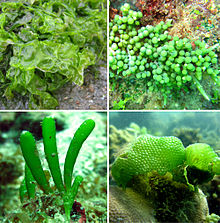The Ulvophyceae or ulvophytes are a class of green algae,[3] distinguished mainly on the basis of ultrastructural morphology, life cycle and molecular phylogenetic data.[4] The sea lettuce, Ulva, belongs here. Other well-known members include Caulerpa, Codium, Acetabularia, Cladophora, Trentepohlia and Monostroma.
| Ulvophyceae Temporal range:
| |
|---|---|

| |
| diversity of Ulvophyceae | |
| Scientific classification | |
| Clade: | Viridiplantae |
| Division: | Chlorophyta |
| Clade: | UTC clade |
| Class: | Ulvophyceae Stewart & Mattox, 1978[1][2] |
| Orders[3] | |
The Ulvophytes are diverse in their morphology and their habitat. Most are seaweeds such as those listed above. Others, such as Rhizoclonium, Pithophora and some species of Cladophora live in fresh water[5] and in some areas are considered weeds.[6]
Evolution
editThe origin and early diversification of the Ulvophyceae likely took place in the late Neoproterozoic,[7][8] though may have taken place earlier, in the Mesoproterozoic.[9] Although most contemporary ulvophytes are marine macroalgae (seaweeds), ancestral ulvophytes may have been freshwater, unicellular green algae. Molecular phylogenetic evidence suggests that macroscopic growth was achieved independently in the various major lineages of Ulvophyceae (Ulvales-Ulotrichales, Trentepohliales, Cladophorales, Bryopsidales and Dasycladales).[8] The earliest known representative is the cladophorales Proterocladus antiquus from the Mesoproterozoic-Neoproterozoic boundary in North China.[10]
Current hypothesis on relationships among the main clades of Ulvophyceae[11][12] are shown below.
See also
editReferences
edit- ^ Stewart KD, Mattox KR (April 1978). "Structural evolution in the flagellated cells of green algae and land plants". Bio Systems. 10 (1–2): 145–152. doi:10.1016/0303-2647(78)90036-9. PMID 656563.
- ^ Adl SM, Simpson AG, Farmer MA, Andersen RA, Anderson OR, Barta JR, et al. (2005). "The new higher level classification of eukaryotes with emphasis on the taxonomy of protists" (PDF). The Journal of Eukaryotic Microbiology. 52 (5): 399–451. doi:10.1111/j.1550-7408.2005.00053.x. PMID 16248873.
- ^ a b Guiry MD, Guiry GM (2007). "Class: Ulvophyceae taxonomy browser". AlgaeBase version 4.2 World-wide electronic publication, National University of Ireland, Galway. Retrieved 2023-06-17.
- ^ Graham LE, Graham JM, Wilcox LW (2009). Algae (2nd ed.). San Francisco, CA: Benjamin Cummings (Pearson).
- ^ O'Kelly CJ (2007). "The Origin and Early Evolution of Green Plants". Evolution of Primary Producers in the Sea. Academic Press. p. 297. doi:10.1016/B978-012370518-1/50014-X. ISBN 9780123705181.
- ^ "Terms for Weeds Your Lake Bottom Blanket Prevents". Lakemat. 2 November 2019. Archived from the original on 26 September 2020.
- ^ Verbruggen H, Ashworth M, LoDuca ST, Vlaeminck C, Cocquyt E, Sauvage T, et al. (March 2009). "A multi-locus time-calibrated phylogeny of the siphonous green algae". Molecular Phylogenetics and Evolution. 50 (3): 642–653. doi:10.1016/j.ympev.2008.12.018. PMID 19141323.
- ^ a b Cocquyt E, Verbruggen H, Leliaert F, De Clerck O (September 2010). "Evolution and cytological diversification of the green seaweeds (Ulvophyceae)". Molecular Biology and Evolution. 27 (9): 2052–2061. doi:10.1093/molbev/msq091. PMID 20368268.
- ^ Hou Z, Ma X, Shi X, Li X, Yang L, Xiao S, et al. (March 2022). "Phylotranscriptomic insights into a Mesoproterozoic-Neoproterozoic origin and early radiation of green seaweeds (Ulvophyceae)". Nature Communications. 13 (1): 1610. doi:10.1038/s41467-022-29282-9. PMC 8941102. PMID 35318329.
- ^ Tang Q, Pang K, Yuan X, Xiao S (February 2020). "A one-billion-year-old multicellular chlorophyte". Nature Ecology & Evolution. 4: 543–549. doi:10.1038/s41559-020-1122-9. PMC 8668152.
- ^ Leliaert F, Smith DR, Moreau H, Herron MD, Verbruggen H, Delwiche CF, et al. (2012). "Phylogeny and molecular evolution of the green algae" (PDF). Critical Reviews in Plant Sciences. 31: 1–46. doi:10.1080/07352689.2011.615705. S2CID 17603352.
- ^ Škaloud P, Kalina T, Nemjová K, De Clerck O, Leliaert F (February 2013). "Morphology and Phylogenetic Position of the Freshwater Green Microalgae Chlorochytrium (Chlorophyceae) and Scotinosphaera (Scotinosphaerales, ord. nov., Ulvophyceae)". Journal of Phycology. 49 (1): 115–129. doi:10.1111/jpy.12021. PMID 27008394. S2CID 7359581.